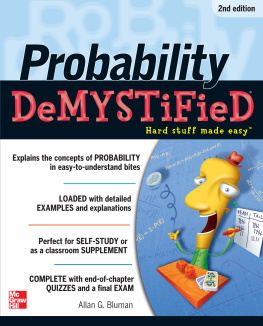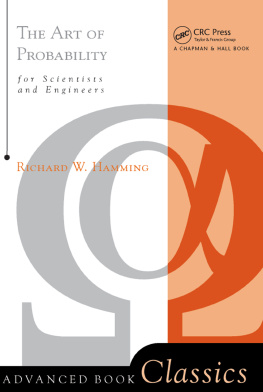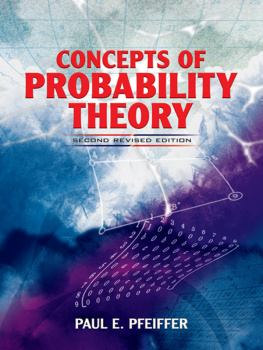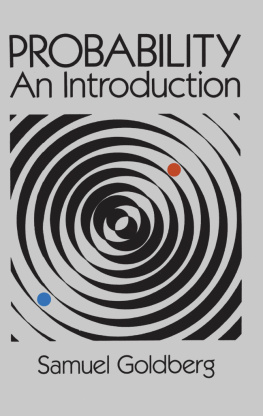 SEYMOUR LIPSCHUTZ, who is presently on the mathematics faculty at Temple University, formerly taught at the Polytechnic Institute of Brooklyn and was visiting professor in the Computer Science Department of Brooklyn College. He received his Ph.D. in 1960 at the Courant Institute of Mathematical Sciences of New York University. Some of his other books in the Schaums Outline Series are Beginning Linear Algebra, Discrete Mathematics, and Linear Algebra. MARC LARS LIPSON is on the faculty at the University of Virginia and formerly taught at Northeastern University, Boston University, and the University of Georgia. in finance in 1994 from the University of Michigan. in finance in 1994 from the University of Michigan.
SEYMOUR LIPSCHUTZ, who is presently on the mathematics faculty at Temple University, formerly taught at the Polytechnic Institute of Brooklyn and was visiting professor in the Computer Science Department of Brooklyn College. He received his Ph.D. in 1960 at the Courant Institute of Mathematical Sciences of New York University. Some of his other books in the Schaums Outline Series are Beginning Linear Algebra, Discrete Mathematics, and Linear Algebra. MARC LARS LIPSON is on the faculty at the University of Virginia and formerly taught at Northeastern University, Boston University, and the University of Georgia. in finance in 1994 from the University of Michigan. in finance in 1994 from the University of Michigan.
He is also coauthor of Schaums Outline of Discrete Mathematics with Seymour Lipschutz. Copyright 2011 by The McGraw-Hill Companies, Inc. All rights reserved. Except as permitted under the United States Copyright Act of 1976, no part of this publication may be reproduced or distributed in any form or by any means, or stored in a database or retrieval system, without the prior written permission of the publisher. ISBN: 978-0-07-181658-8
MHID: 0-07-181658-5 The material in this eBook also appears in the print version of this title: ISBN: 978-0-07-175561-0, MHID: 0-07-175561-6. eBook conversion by codeMantra
Version 2.0 All trademarks are trademarks of their respective owners.
Rather than put a trademark symbol after every occurrence of a trademarked name, we use names in an editorial fashion only, and to the benefit of the trademark owner, with no intention of infringement of the trademark. Where such designations appear in this book, they have been printed with initial caps. McGraw-Hill eBooks are available at special quantity discounts to use as premiums and sales promotions, or for use in corporate training programs. To contact a representative please e-mail us at bulksales@mcgraw-hill.com. Trademarks: McGraw-Hill, the McGraw-Hill Publishing logo, Schaums and related trade dress are trademarks or registered trademarks of The McGraw-Hill Companies and/or its affiliates in the United States and other countries and may not be used without written permission. All other trademarks are the property of their respective owners.
The McGraw-Hill Companies is not associated with any product or vendor mentioned in this book. TERMS OF USE This is a copyrighted work and The McGraw-Hill Companies, Inc. (McGraw-Hill) and its licensors reserve all rights in and to the work. Use of this work is subject to these terms. Except as permitted under the Copyright Act of 1976 and the right to store and retrieve one copy of the work, you may not decompile, disassemble, reverse engineer, reproduce, modify, create derivative works based upon, transmit, distribute, disseminate, sell, publish or sublicense the work or any part of it without McGraw-Hills prior consent. You may use the work for your own noncommercial and personal use; any other use of the work is strictly prohibited.
Your right to use the work may be terminated if you fail to comply with these terms. THE WORK IS PROVIDED AS IS. McGRAW-HILL AND ITS LICENSORS MAKE NO GUARANTEES OR WARRANTIES AS TO THE ACCURACY, ADEQUACY OR COMPLETENESS OF OR RESULTS TO BE OBTAINED FROM USING THE WORK, INCLUDING ANY INFORMATION THAT CAN BE ACCESSED THROUGH THE WORK VIA HYPERLINK OR OTHERWISE, AND EXPRESSLY DISCLAIM ANY WARRANTY, EXPRESS OR IMPLIED, INCLUDING BUT NOT LIMITED TO IMPLIED WARRANTIES OF MERCHANTABILITY OR FITNESS FOR A PARTICULAR PURPOSE. McGraw-Hill and its licensors do not warrant or guarantee that the functions contained in the work will meet your requirements or that its operation will be uninterrupted or error free. Neither McGraw-Hill nor its licensors shall be liable to you or anyone else for any inaccuracy, error or omission, regardless of cause, in the work or for any damages resulting therefrom. McGraw-Hill has no responsibility for the content of any information accessed through the work.
Under no circumstances shall McGraw-Hill and/or its licensors be liable for any indirect, incidental, special, punitive, consequential or similar damages that result from the use of or inability to use the work, even if any of them has been advised of the possibility of such damages. This limitation of liability shall apply to any claim or cause whatsoever whether such claim or cause arises in contract, tort or otherwise.
PREFACE
Probability theory had its beginnings in the early seventeenth century as a result of investigations of various games of chance. Since then many leading mathematicians and scientists made contributions to this theory. However, despite its long and active history, probability theory was not axiomatized until the twentieth century. This axiomatic development, called modern probability theory, was then able to make the concepts of probability precise and place them on a firm mathematical foundation.
This book is designed for an introductory course in probability with high school algebra as the main prerequisite. It can serve as a text for such a course, or as a supplement to all current comparable texts. The book should also prove to be useful as a supplement to texts and courses in statistics. Furthermore, as the book is complete and self-contained it can easily be used for self-study. This new edition includes and expands the content of the first edition. It begins with a chapter on sets and their operations, and then with a chapter on techniques of counting.
Next comes a chapter on probability spaces, and then a chapter on conditional probability and independence. The fifth and main chapter is on random variables where we define expectation, variance, and standard deviation, and prove Chebyshevs inequality and the law of large numbers. Although calculus is not a prerequisite, both discrete and continuous random variables are considered. We follow with a separate chapter on specific distributions, mainly the binomial, normal, and Poisson distributions. Here the central limit theorem is given in the context of the normal approximation to the binomial distribution. The seventh and last chapter offers a thorough elementary treatment of Markov chains with applications.
This new edition also has two new appendixes. The first is on descriptive statistics where expectation, variance, and standard deviation are again defined, but now in the context of statistics. This appendix also treats bivariate data, including scatterplots, the correlation coefficient, and methods of least squares. The second appendix discusses the chi-square distribution and various applications in the context of testing hypotheses. These two new appendixes motivate many of the concepts which appear in the chapters on probability, and also make the book even more useful as a supplement to texts and courses in statistics. The positive qualities that distinguished the first edition have been retained.
Each chapter begins with clear statements of pertinent definitions, principles, and theorems together with illustrative and other descriptive material. This is followed by graded sets of solved and supplementary problems. The solved problems serve to illustrate and amplify the theory, and provide the repetition of basic principles so vital to effective learning. Proof of most of the theorems is included among the solved problems. The supplementary problems serve as a complete review of the material of each chapter. Finally, we wish to thank the staff of McGraw-Hill, especially Barbara Gilson and Maureen Walker, for their excellent cooperation.
SEYMOUR LIPSCHUTZ
Temple University MARC LARS LIPSON
Next page






 SEYMOUR LIPSCHUTZ, who is presently on the mathematics faculty at Temple University, formerly taught at the Polytechnic Institute of Brooklyn and was visiting professor in the Computer Science Department of Brooklyn College. He received his Ph.D. in 1960 at the Courant Institute of Mathematical Sciences of New York University. Some of his other books in the Schaums Outline Series are Beginning Linear Algebra, Discrete Mathematics, and Linear Algebra. MARC LARS LIPSON is on the faculty at the University of Virginia and formerly taught at Northeastern University, Boston University, and the University of Georgia. in finance in 1994 from the University of Michigan. in finance in 1994 from the University of Michigan.
SEYMOUR LIPSCHUTZ, who is presently on the mathematics faculty at Temple University, formerly taught at the Polytechnic Institute of Brooklyn and was visiting professor in the Computer Science Department of Brooklyn College. He received his Ph.D. in 1960 at the Courant Institute of Mathematical Sciences of New York University. Some of his other books in the Schaums Outline Series are Beginning Linear Algebra, Discrete Mathematics, and Linear Algebra. MARC LARS LIPSON is on the faculty at the University of Virginia and formerly taught at Northeastern University, Boston University, and the University of Georgia. in finance in 1994 from the University of Michigan. in finance in 1994 from the University of Michigan.